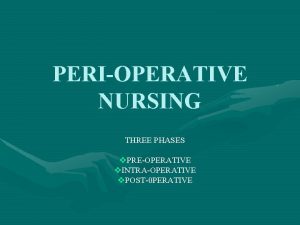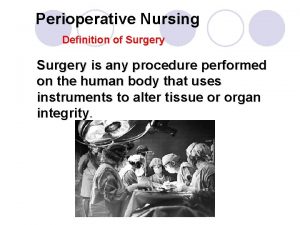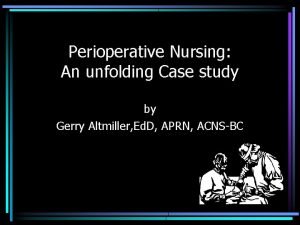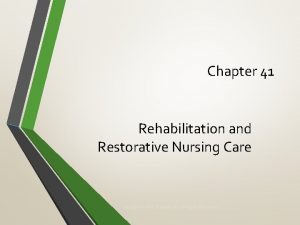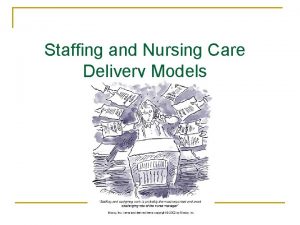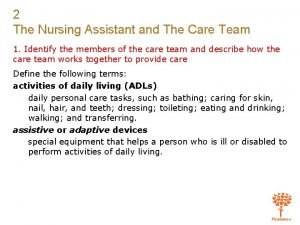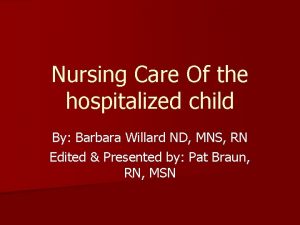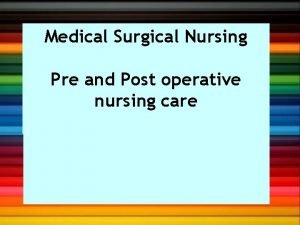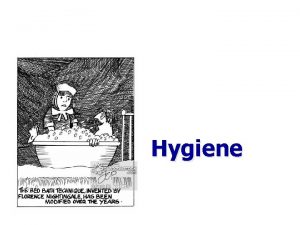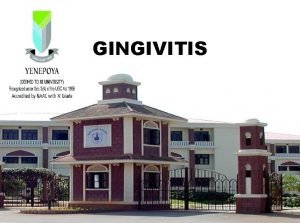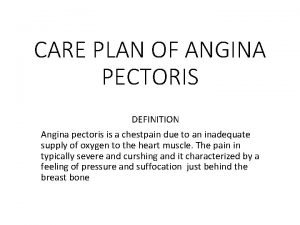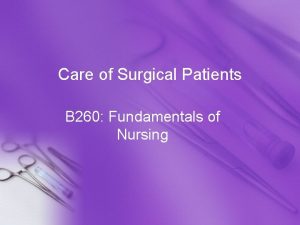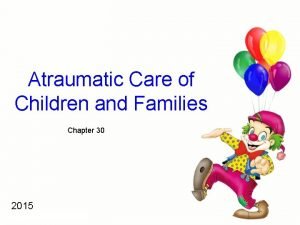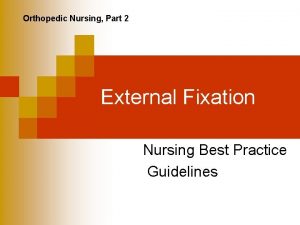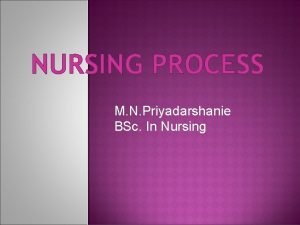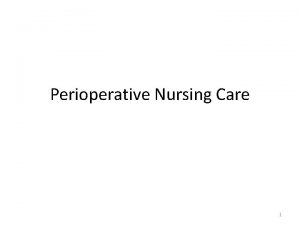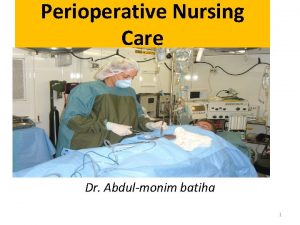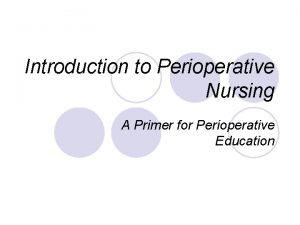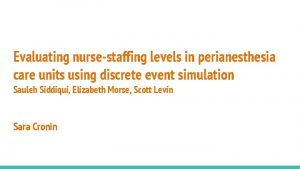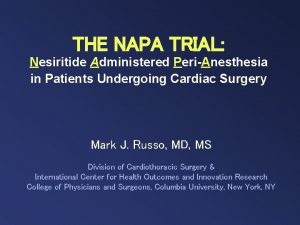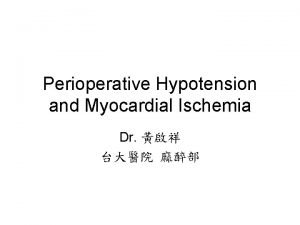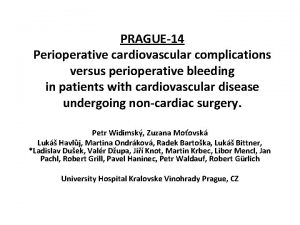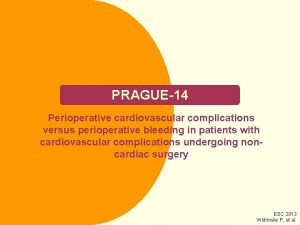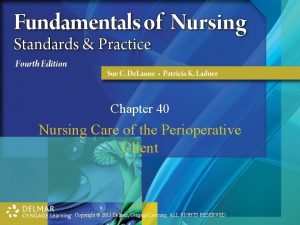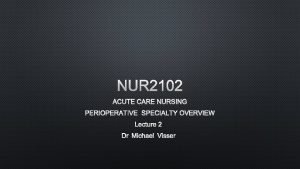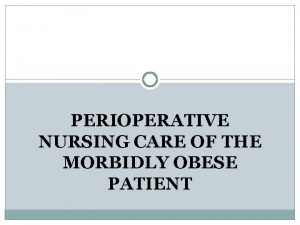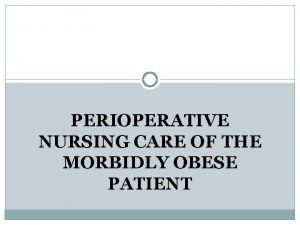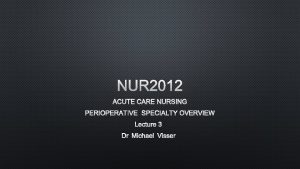Perioperative Nursing Care 1 Perianesthesia and Perioperative Nursing






































- Slides: 38

Perioperative Nursing Care 1

Perianesthesia and Perioperative Nursing is the field of nursing that addresses the nursing roles associated with the three phases of surgical experiences : pre operative postoperative and intraoperative 2

Preoperative Nursing Care: • begins when the decision to proceed with surgical intervention is made and end with the transfer of patient to the operation table 3

Pre-Operative Responsibilities of Operating Room Nurse: • Patient Assessment • Physical Problems • Emotional Aspects • Understanding of surgery/consent • Legal requirements for chart completion • Read and interpret lab results • Peri. Operative Teaching

PREOPERATIVE NURSING CONSIDERATIONS • COMPLETE PHYSICAL ASSESSMENT – Physical & psychological needs – Medical & surgical history – Completion of required documents • DETERMINE READINESS & MODE OF TRANSPORTATION TO OR • ACCESS HEALTH CARE TEAM AVAILABILITY – – – Surgeon Anesthesia personnel Circulating nurse Scrub person Other personnel

PRE-OP MEDS • Pharmacologic preparation as necessary & psychological support • Facilitates induction of anesthesia & reduces anesthetic requirement • Determinants of drug choice – – – Age Weight Level of anxiety Drug allergies Inpatient/outpatient Timing of administration

Examples of nursing activities in the preoperative phase include : Pre admission testing • • Initial preoperative assessment Initiate teaching appropriate to patients needs Involve family in interview Verify completion of preoperative testing 7

Admission to surgical unite or center • Complete the preoperative assessment • Assess for risk of complications • Report upnormal findings • Verify that informed consent obtained • Answers family questions • Develop a plan of care 8

Others also in the holding area prior to the surgery • • • Review patient chart Identify patient Verify surgical site Establish intravenous line eg canula Administer prescribed medications Provide support 9

Intra-Operative • • Provide for quiet environment during induction Assist during intubation Observe aseptic technique Safe operation of equipment (lasers, electrosurgery unit) Position patient safely - CV, nervous, respiratory system Document events, patient care given, Provide all supplies, equipment, to team during surgery Provide for a safe transfer to recovery room

Intraoperative Nursing Care • Begins when patient is transferred to onto the operation table and ends with admission to the post anesthesia care unite Main nursing activities include • Maintain safety • Maintain aseptic environment • Transfer patient to operation room or table • Position the patient in correct alignment • Ensure that instruments count are correct • Complete documentation 11

Physiologic monitoring • Calculate fluid loss or gain • Distinguish normal and abnormal data • Report changes in vital sign Physiologic support • Provide emotional support 12

Postoperative Nursing Care • Begins when patient is admitted to the post anesthesia care unite and end with follow up evaluation in home or clinical setting Activities include • • • Maintain airway Monitor vital sign Assess the effect of anesthetic agents Assess complications assess pain Promote recovery and initiate teaching Initiate discharge plan 13

Surgical classification ( according to urgency) • Emergent : immediately with no delay eg sever bleeding • Urgent: patient needs prompt attention must be done within 24 hrs eg gall bladder infection and kidney stone • Required : patient must have surgery within few weeks or months eg cataract, Thyroid disorder • Elective : failure to have surgery has some impact on patient life but not very dangerous eg repair of scare and simple hernia • Optional : personal preference eg cosmetics 14

Preparation for Surgery Informed Consent • process for getting permission before conducting a healthcare intervention on a person. A health care provider may ask a patient Which procedures need informed consent ? • Invasive procedure such as need anesthesia • Non surgical procedure that carry considerable risk such as arteriography • Procedures that involve radiation 15

Criteria for valid informed consent • Voluntary • Must be written • Patient must be competent and able to comprehend • In case of incompetent patient family member or law representatives may give consent • Should contain explanation of procedure • Instruction that patient can withdraw consent • Explanation that all patients questions would be answered and if there is any significant notes such as change in customary procedure 16

Assessment of health factor that affect patient preoperatively • Nutritional and fluid status • Drug and alcohol abuse • Respiratory status • Cardiovascular status • Hepatic and renal function • Endocrine function • Immune function • Previous medication use • Psychosocial factors • Spiritual and cultural beliefs 17

Special situations • Ambulatory surgery : patient discharge the same day of surgery • Obese patient • Emergency surgery 18

Preoperative nursing intervention • Preoperative teaching • Deep breathing coughing exercise • Teach patient how to promote mobility and active body movement by frequent position • Leg exercise • Getting out of bed • Pain management • Coping strategies • Reduce anxiety and fear 19

• • Maintain patient safety Manage fluid status Prepare the bowel Prepare the skin 20

Immediate preoperative nursing interventions • Administer pre anesthetic medications • Maintain preoperative records • Transport patient to the operation room 21

Patients @ High risk for Complications • • Smokers Obese Chronic Lung Diseases Elderly HTN Thoracic or Abdominal Surgeries Immobilizing Surgery • • UTI Diabetes Poor Nutritional Status Dehydration Heart Disease Self-fulfilling Prophecy Inhalant Anesthesia

PREVENTING COMPLICATIONS DVT, UTI, Aspiration, Wound Infection, Shock, Constipation • • • Identify those @ risk Provide adequate hydration/nutrition NPO after MN Leg exercises Breathing exercises and IS I&O

Preventing Complications… • • • Splint Incision to cough Anticoagulant Therapy - Heparin Ambulate and OOB to BRP - ASAP Discourage smoking Fluid and fiber ASAP, laxatives. Enemas Clean Hands Instruct in proper wound care Sterile bowel prep and skin prep Sleep/Rest

PREPPING THE PATIENT TEACHING • Name and purpose of the surgery • NPO after MN and why early awakening, shower, remove all jewelry, makeup, etc • Anesthesia, Cold Room, Smells, Drowsy Feeling • Recovery Room • Post-op care - TCDB, leg exercises, pain management, DVT< OOB ASAP • Begin discharge planning

WAYS TO DECREASE ANXIETY COMMUNICATION • • • Early teaching and counseling Diversional activities Encourage family support Encourage verbalization of fears/loss of control Deep breathing, medications, imagery, music

Ways to Decrease Anxiety… • Spiritual support (communion, bible reading, prayers, rituals, chants) • Inform family where to wait, buy food, bathroom, phone, overnight and visiting policy • Possible use of sedative or tranquilizer or PRN medications • Dolls/favorite toy for children

NURSING ASSESSMENT • Assessment Data Base - vital signs, weight, height • Review of Systems • Past history of illnesses (i. e. HTN, pneumonia) that may predispose client to complications • Past experience with hospitalization or surgery • Allergies to medications or foods, tapes, surgical scrubs

Nursing Assessment… • Intellectual ability to understand teaching • Language differences, social, spiritual or cultural considerations, anxiety level • Labs: CBC; U/A; Chemistry (electrolytes: K, CL, NA, CA, BS, BUN, Creatine), total bilirubin, albumin, alkaline phosphatase, SGOT, HCO 3, HIV, Pregnancy • Other: Chest X-Ray, EKG if > 40 years old

PRE-OP NURSING DIAGNOSES • Knowledge Deficit R/T Unfamiliar Planned or Unplanned Surgery • Ineffective individual or family coping R/T Unfamiliar Planned or Unplanned Surgery • Anticipatory Grieving R/T Potential for Loss of Life or Body Part

NURSING RESPONSIBLITIES • Informed Consent Form/Patient Advocacy • Secure personal belongings: Dentures, glasses, rings, money • Administration of pre-op medications on call to OR - i. e. Demerol, Valium, Atropine • Complete Pre-op Checklist @ clinical site - remove hair pins, loose teeth, dentures, nail polish, bath, urinate, NPO, VS taken within 15 minutes of going to OR, Ted Hose or compression devices

NURSING RESPONSIBLITIES. . . • Report anything of note that needs to be brought to the attention of the anesthesiologist, surgeon, or OR nurse • • • low potassium, fever, arrthymias, loose teeth, chest pain, or anything unusual • Assure patient has ID bracelet on; Send current chart and any old medical records with the patient; • EVALUATE patients level of understanding, physical stability, emotionally prepared, fulfilled hospital pre-op policies

TYPES OF SURGERY • MAJOR -- Present a real threat to life MAJOR • MINOR -- Present little threat to life MINOR NOTE: **** All patients consider their NOTE: **** surgery a major thing ****

Catastrophic Events in the OR Anticipated: Anticipated • Cardiac Arrest in an unstable patient • Massive Blood Loss - during trauma surgery • Loss of ability to ventilate a patient

Catastrophic Events in OR. . . Unanticipated: • Latex Allergy Reaction - reactions can range from urticaria to Latex Allergy Reaction anaphylaxis • Maligant Hyperthermia - rare, life-threatening disorder that Maligant Hyperthermia can be triggered by anesthesia drugs - Is an autosomal dominant trait

Peri-Operative Standards of Care (example) • • All Policy & Procedures of the medical and surgical nursing division will be followed. Patients shall ALWAYS wear a legible identification band Operative permit(s) must be signed and witnessed according to hospital policy, The procedure documented on the operative permit MUST MATCH what is scheduled on the OR schedule The history and physical shall be completed according to policy and be part of the medical record prior to surgery All ordered lab work shall be collected and results placed in the medical record in accordance with the physician’s orders Dentures, hairpins, jewelry, wigs, contact lenses, nail polish, make-up and prosthesis shall be removed as requested by the physician Any jewelry not removed shall be secured with tape and documented as such

Peri-Operative Standards of Care … • • Pre-operative skin prep shall be done without abrading, cutting or irritating the patient’s skin Patient privacy shall be provided at all times Any pre-operative drainage tubes shall be placed without tissue trauma and be completed utilizing sterile techniques when indicated All IV infusions shall be monitored to maintain the appropriate flow rate and type of solution and remain patent without signs of inflammation or swelling The patient shall be provided emotional and educational support to reduce pre-operative anxiety The patients shall be provided a safe and normothermic environment in the pre-op waiting area The patient shall be transferred safely to the OR table and safety straps appropriately applied

Expected Outcomes: • Demonstrate knowledge of physiologic & psychological responses to surgical intervention • Absence of infection • Maintenance of skin integrity • Freedom from injury R/T positioning, equipment • Maintenance of fluid and electrolyte balance • Satisfaction with pain relief • Participation in the rehab process
 Perioperative care phases
Perioperative care phases Nursing management preoperative care
Nursing management preoperative care Post operative nursing management
Post operative nursing management Perioperative case study nursing
Perioperative case study nursing Primary secondary tertiary care definition
Primary secondary tertiary care definition Nursing intervention for ocd
Nursing intervention for ocd Nursing care plan for cataract patient
Nursing care plan for cataract patient Canadian perioperative guidelines
Canadian perioperative guidelines Unit 2 equality diversity and rights
Unit 2 equality diversity and rights Chapter 41 rehabilitation and restorative nursing care
Chapter 41 rehabilitation and restorative nursing care Functional method of nursing care delivery
Functional method of nursing care delivery Modular nursing definition
Modular nursing definition The nursing assistant and the care team chapter 2
The nursing assistant and the care team chapter 2 Cleft lip and palate post operative care nursing diagnosis
Cleft lip and palate post operative care nursing diagnosis Chapter 2 the nursing assistant and the care team
Chapter 2 the nursing assistant and the care team Care certificate duty of care
Care certificate duty of care Magneti artificiali
Magneti artificiali Palliative care versus hospice care
Palliative care versus hospice care Inmultirea la animale
Inmultirea la animale Care sunt simturile prin care sunt evocate
Care sunt simturile prin care sunt evocate Standard 1 care certificate answers
Standard 1 care certificate answers Hip fracture care clinical care standard
Hip fracture care clinical care standard Nursing process
Nursing process Nursing care plan hallucinations
Nursing care plan hallucinations Position of patient
Position of patient Nursing diagnosis three parts
Nursing diagnosis three parts Nursing care of hospitalized child
Nursing care of hospitalized child Post operative nursing care
Post operative nursing care Nail care procedure in nursing
Nail care procedure in nursing Nursing care plan for gingivitis
Nursing care plan for gingivitis Care plan for angina
Care plan for angina Post operative nursing care
Post operative nursing care Autramatic care
Autramatic care Atraumatic care definition
Atraumatic care definition Henderson nursing definition
Henderson nursing definition Somatic symptom disorder
Somatic symptom disorder External fixation device nursing care
External fixation device nursing care Nursing care plan case scenario
Nursing care plan case scenario Nursing care of hospitalized child
Nursing care of hospitalized child
